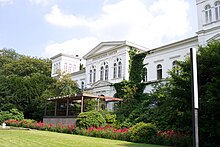Wuppertal Zoo
| Wuppertal Zoo | |
|---|---|
 Zoo-Gaststättengebäude | |
 | |
| 51°14′23″N 7°06′44″E / 51.23972°N 7.11222°E | |
| Date opened | 8 September 1881 |
| Location | Wuppertal, Germany |
| Land area | 24 ha (59 acres) |
| No. of animals | 5,000 |
| No. of species | 500 |
| Website | www |
Wuppertal Zoo (Template:Lang-de or Zoo Wuppertal) is a 24-hectare (59-acre) zoo in Wuppertal, Germany. About 5,000 animals representing about 500 species from around the world live at the zoo, including apes, monkeys, bears, big cats, elephants, as well as birds, reptiles, and fish.
History
The zoo was founded on 5 December 1879. The central building opened together with the zoo itself on 8 September 1881. It featured 34 animals, among them a pair of wolves and a bear.[1] Since then, the zoo has been steadily expanded.
The gorilla enclosure was updated and expanded to 525 square metres (5,650 sq ft) in 2006, coinciding with the 125th anniversary of the opening of the zoo. Visitors can view the gorillas through a large glass window. The drill baboon enclosure was also renovated in 2006.[2]
On 24 May 2007, the zoo opened a new enclosure for lions and tigers. The 1-hectare (2.5-acre) lion enclosure is claimed to be the largest in a German zoo, and the Siberian tigers now live in several enclosures in the Valley of Tigers.[3]
Anori, a polar bear cub born on 4 January 2012, who shares a father with the internationally well-known late polar bear Knut, made her debut to the public alongside her mother Vilma on Thursday, 29 March 2012. Until then, a camera inside their enclosure had been monitoring her progress learning to walk and get around.[4]
Exhibits
Modern enclosures and zoo buildings exist for elephants and apes, there is a house for birds with a specially designed hall, where freely flying birds can be observed, and a small combined aquarium/terrarium.
Location
The zoo lies in the western part of Wuppertal on the so-called "Boltenberg" between Elberfeld and Vohwinkel.
Public transport is available in the immediate vicinity. The Wuppertaler Schwebebahn and Wuppertal Zoologischer Garten station on the Rhine-Ruhr S-Bahn (S8, S9) are close by. Arriving by car via the Autobahn 46 is possible but not recommended, since parking lots are in very short supply.
References
- ^ "Zoo History". zoo-wuppertal.de. Wuppertal Zoo. Retrieved 31 March 2012.
- ^ "Zoo Today". zoo-wuppertal.de. Wuppertal Zoo. Retrieved 31 March 2012.
- ^ "Lions and Tigers". zoo-wuppertal.de. Wuppertal Zoo. Retrieved 31 March 2012.
- ^ Smith-Spar, Laura (31 March 2012). "Polar bear Knut's half-sister makes public debut". cnn.com. CNN. Retrieved 31 March 2012.
External links
 Media related to Zoo Wuppertal at Wikimedia Commons
Media related to Zoo Wuppertal at Wikimedia Commons- Official website
